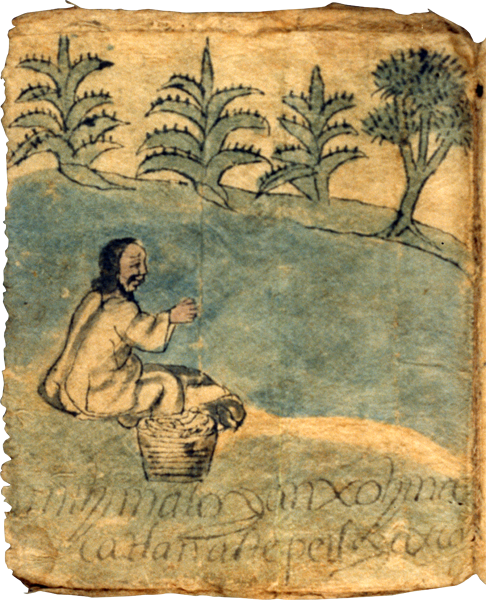entire face of one folio (pictorial and textual)
This page, which is the back side of the fifteenth folio of sixteen folios (also Book VII, folio 3 verso), is typical of the image-heavy pages that feature landscapes included in these territorial claims of Santa María Iztacapan (modern State of Hidalgo, Mexico) late in the Spanish colonial period.
This is a scene with an individual, indigenous male seated by a river. He may be fishing, as a basket appears next to him, and he holds his right hand out as though he may be holding a fishing line, although no pole appears. The basket, outlined in black and washed with a gray paint, may have a rope handle, and it is constructed in such a way that 8-10 horizontal lines appear from top to bottom. The scene is reminiscent of Book V, Folio 3r.
The river is outlined in black and painted with a turquoise blue watercolor. On the far side of the river are three magueyes (agaves) and one tree or tall bush. They are outlined in black and washed with green. The shore is also outlined in black and washed with green. The man, on the shore of the river that is closest to the viewer, is also outlined in black and wears what appears to be white-cotton, Spanish-colonial style clothing — probably a shirt and pants. Two rows of text appear across the bottom of this page. [SW]
Página entera de un folio
Esta página, la contratapa del decimoquinto de dieciséis folios (también Libro VII, folio 2 recto), es la típica página cargada de imágenes que presenta paisajes incluídos en los reclamos territoriales de Santa María de Iztacapan (estado moderno de Hidalgo, México0 a finales del período colonial español.
En esta escena vemos a un hombre indígena sentado a orillas de un río. Puede estar pescando, ya que tiene un cesto a su lado, y parecería estar sosteniendo una linea en su mano derecha (aunque no se ve una caña). El cesto, delineado en negro y coloreado en gris, podría tener una manija de soga, y está construido de tal forma que tiene 8-10 lineas horizontales. La escena es similar a la del Libro V, Folio 3r.
El río está delineado en negro y pintado con acuarelas turquezas. Al otro lado del río hay tres magueyes (agaves) y un árbol alto. Están delineados en negro y coloreados en verde. La orilla también está delineada en negro y coloreada en verde. El hombre, en la orilla del río mas cercana, también está delineado en negro y vestido en lo que parece ser ropa de algodón blaco al estilo colonial (probablemente una camisa y un pantalón). En la parte inferior de la página hay dos renglones de texto.
